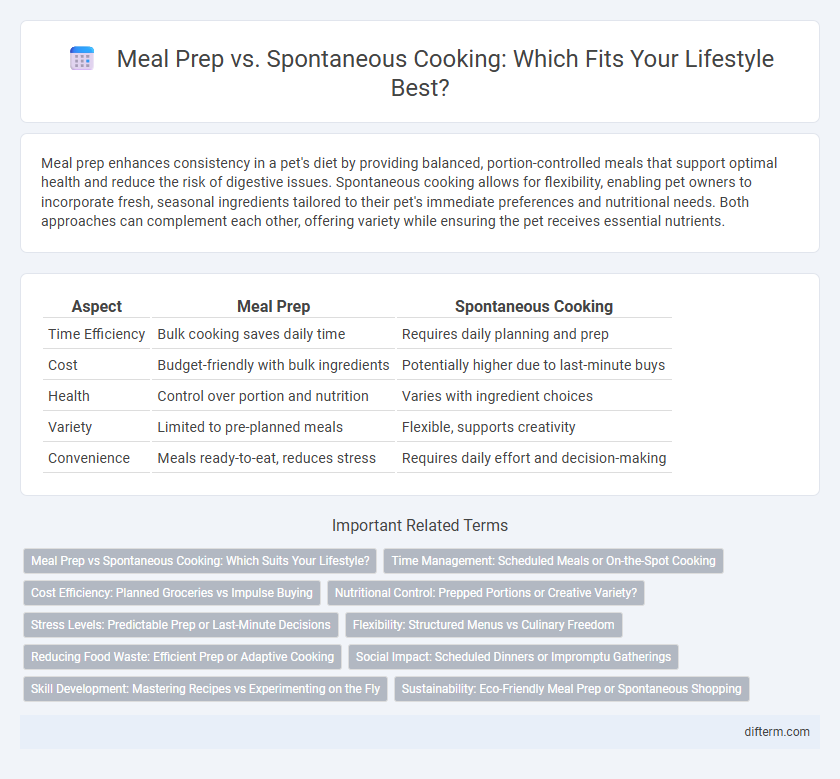Meal prep enhances consistency in a pet's diet by providing balanced, portion-controlled meals that support optimal health and reduce the risk of digestive issues. Spontaneous cooking allows for flexibility, enabling pet owners to incorporate fresh, seasonal ingredients tailored to their pet's immediate preferences and nutritional needs. Both approaches can complement each other, offering variety while ensuring the pet receives essential nutrients.
Table of Comparison
| Aspect | Meal Prep | Spontaneous Cooking |
|---|---|---|
| Time Efficiency | Bulk cooking saves daily time | Requires daily planning and prep |
| Cost | Budget-friendly with bulk ingredients | Potentially higher due to last-minute buys |
| Health | Control over portion and nutrition | Varies with ingredient choices |
| Variety | Limited to pre-planned meals | Flexible, supports creativity |
| Convenience | Meals ready-to-eat, reduces stress | Requires daily effort and decision-making |
Meal Prep vs Spontaneous Cooking: Which Suits Your Lifestyle?
Meal prep offers time-saving benefits and consistent nutrition by planning meals in advance, ideal for busy individuals seeking structure. Spontaneous cooking allows creativity and flexibility, catering to those who prefer variety and enjoy experimenting with fresh ingredients daily. Choosing between meal prep and spontaneous cooking depends on your schedule, dietary goals, and personal preferences for convenience versus culinary exploration.
Time Management: Scheduled Meals or On-the-Spot Cooking
Meal prep maximizes time efficiency by allowing individuals to plan and cook meals in bulk, reducing daily cooking time and minimizing stress during busy weekdays. On-the-spot cooking offers flexibility, enabling adaptation to cravings or ingredient availability but often requires more kitchen time and effort. Effective time management balances these approaches to optimize convenience and maintain a varied, nutritious diet.
Cost Efficiency: Planned Groceries vs Impulse Buying
Meal prep enhances cost efficiency by enabling bulk purchasing of planned groceries, reducing per-meal expenses compared to impulse buying. Spontaneous cooking often leads to higher costs due to frequent small purchases and food waste from unused ingredients. Consistently planned meals support budget control and minimize unnecessary spending on last-minute items.
Nutritional Control: Prepped Portions or Creative Variety?
Meal prep ensures precise nutritional control by portioning meals in advance, making it easier to track calorie intake and balance macronutrients. Spontaneous cooking offers creative variety, allowing the incorporation of fresh, seasonal ingredients that can enhance nutrient diversity. Both methods support healthy eating habits, but meal prep excels in consistency while spontaneous cooking fosters dietary exploration.
Stress Levels: Predictable Prep or Last-Minute Decisions
Meal prep offers structured planning that significantly reduces daily stress by providing ready-to-eat meals and eliminating last-minute cooking decisions. Spontaneous cooking, while potentially fostering creativity, often increases stress levels due to unpredictable ingredient availability and time constraints. Balancing meal prep with occasional spontaneous cooking can optimize stress management and maintain culinary flexibility.
Flexibility: Structured Menus vs Culinary Freedom
Meal prep offers structured menus that streamline nutrition and save time during busy weeks, ensuring balanced meals and portion control. Spontaneous cooking provides greater culinary freedom, allowing creativity and adaptation based on available ingredients or cravings. Both approaches cater to different lifestyle needs, with meal prep emphasizing consistency and spontaneous cooking prioritizing flexibility.
Reducing Food Waste: Efficient Prep or Adaptive Cooking
Meal prep minimizes food waste by planning portions and using ingredients before spoilage, ensuring every item is utilized efficiently. Spontaneous cooking adapts to available leftovers and fresh produce, reducing waste by creatively incorporating what's on hand. Both methods support sustainable eating habits through mindful ingredient management and reducing unnecessary food disposal.
Social Impact: Scheduled Dinners or Impromptu Gatherings
Scheduled dinners foster consistent social connections by creating reliable opportunities for friends and family to gather, while spontaneous cooking encourages organic interactions and flexibility in socializing. Meal prep supports planned communal experiences, reinforcing routine bonding and shared traditions. Impromptu gatherings often lead to diverse social dynamics, promoting creativity and inclusiveness in lifestyle choices.
Skill Development: Mastering Recipes vs Experimenting on the Fly
Meal prep enhances skill development by reinforcing mastery of specific recipes through repetition and precision, fostering culinary confidence and efficiency. Spontaneous cooking cultivates creativity and adaptability, encouraging experimentation with ingredients and techniques that refine intuitive decision-making. Balancing both approaches promotes comprehensive cooking skills, blending consistency with innovation for a versatile culinary repertoire.
Sustainability: Eco-Friendly Meal Prep or Spontaneous Shopping
Eco-friendly meal prep reduces food waste by planning portions and using ingredients efficiently, minimizing the carbon footprint associated with frequent grocery trips. Spontaneous shopping allows purchasing fresh, seasonal produce, which supports local agriculture and decreases reliance on long-distance transportation emissions. Balancing these approaches promotes sustainable eating habits through both waste reduction and support for environmentally responsible food sourcing.
meal prep vs spontaneous cooking Infographic

 difterm.com
difterm.com